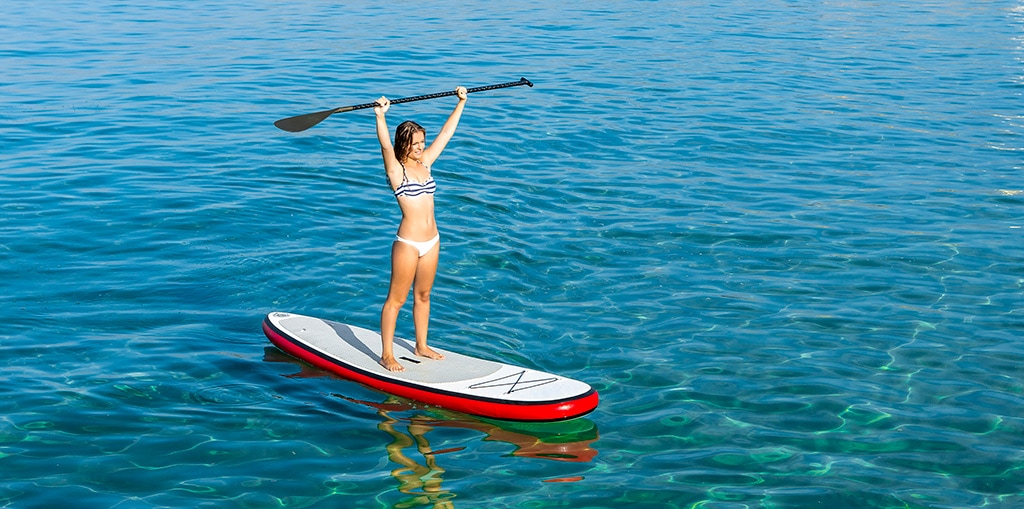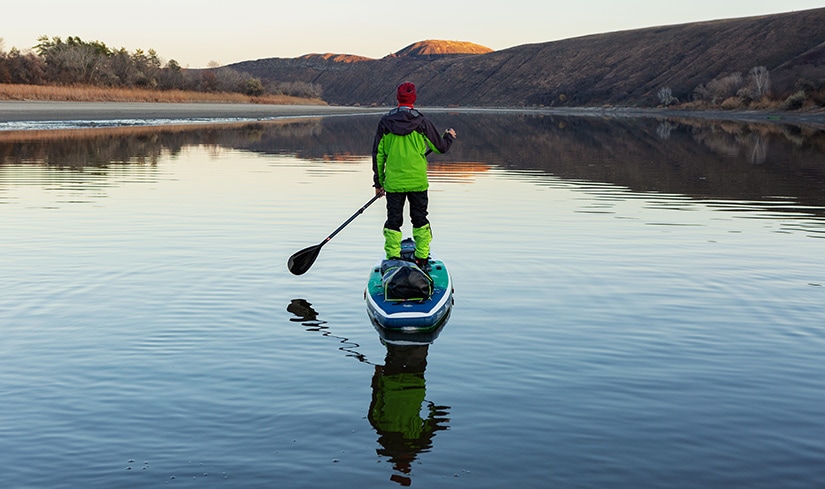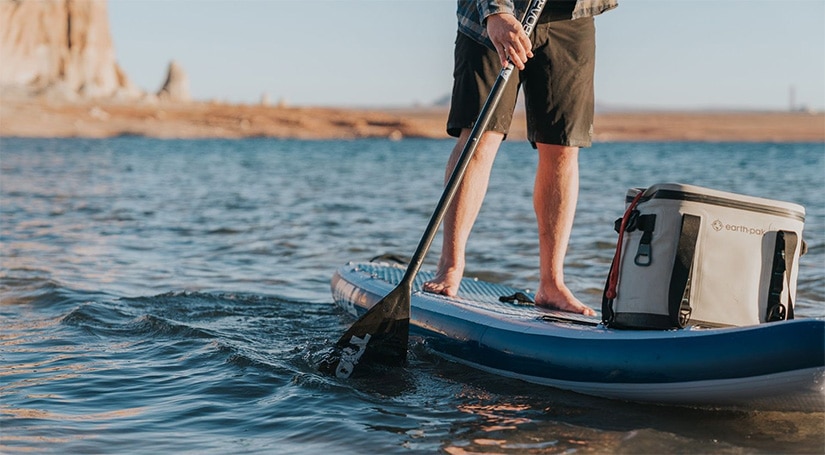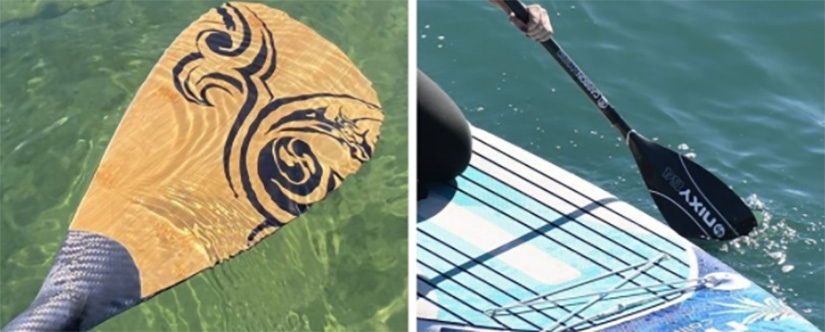You can buy the most expensive SUP on the market, but if your paddle isn’t up to the job, you’ll have a miserable experience.
For most keen paddle boarders, your choice comes down to two options: fiberglass or carbon fiber.
Both materials have pros and cons. In this article, I’ll help you figure out which paddle is best for you—or if there’s an alternative option.
Pros and Cons of Carbon Fiber vs Fibergalss Paddles
While both materials have their advantages, they do come with disadvantages too. It’s a question of weighing the pros and cons of each, and determining which paddle type best suits your needs.
| Paddle Type | Advantages | Disadvantages |
| Carbon Fiber | Extremely lightweight Rigid, for efficient paddling Strong | Expensive Brittle |
| Fiberglass | Durable Affordable More flexible, meaning less strain on your joints | Heavy Less rigid, so paddling requires more power |
Common SUP Paddle Materials
Let’s begin with with a rundown of the most common materials used in SUP paddles.
Aluminum
Cheaper paddles are often made from aluminum paired with a plastic blade. It’s an economical alternative to fiberglass and carbon fiber. You may choose aluminum if you’re on a budget or you’ll be sharing your paddle with other people who may not take quite such good care of it as you!
Plastic
Many budget paddles will have a plastic blade and grip with an aluminum shaft. Plastic is durable and affordable, but it’s heavier than other materials and doesn’t offer the same performance.
Nylon
Nylon offers similar properties and cost-savings as polyurethane plastic. It’s often used to add durability to fiberglass or carbon fiber blades. If you’re worried about damaging your paddle with everyday wear and tear, a nylon blade might be a good option.
Wood
Wooden paddles have a traditional appeal and a beautiful aesthetic. They don’t have the same performance as carbon fiber, but some paddle boarders prefer the feel of wood. If you want a unique paddle or prefer to use natural materials, then a wooden paddle might suit you.
Fiberglass
Fiberglass balances performance and cost. It’s cheaper than carbon fiber but lighter and stiffer than an aluminum/plastic paddle. Fiberglass is a great choice for most paddle boarders. It’s sometimes blended with carbon to create a composite shaft that balances weight and cost.
Carbon Fiber
Carbon fiber is the most lightweight and expensive material used to make SUP paddles. It’s exceptionally strong and stiff, but for most recreational paddles, it’s not an economical choice.
You may choose a carbon fiber paddle if weight and performance are crucial, for example, if you’re racing or paddling exceptionally long distances.
For most serious paddle boarders, your choice of material comes down to fiberglass or carbon.
Carbon Fiber vs Fiberglass – Let the Battle Commence!
It’s a subject of endless debate that can keep a group of paddle boarders arguing for hours. Let’s pit these two materials against each other to see which comes out on top.
Weight – Which Is Heavier?
If you’re choosing a paddle based on weight alone, there’s no contest. Carbon fiber outshines fiberglass every time.
A fixed carbon fiber paddle can weigh as little as 14 ounces. That’s the same weight as an American football. 3-piece paddles come in slightly heavier—around 20-25 ounces.
It’s hard to compare a pure carbon and pure fiberglass paddle, as most fiberglass paddles have some element of carbon in them. The construction methods used also make a big difference. However, pure carbon fiber is around 30% lighter than fiberglass.
Many cheaper carbon fiber paddles are actually composites. You may have a blended material or simply have a carbon coating over fiberglass. Carbon fiber composites may be around 15% lighter than fiberglass.
The winner: carbon fiber
Rigidity – Which Is Better For Paddling?
The most important factor for performance is rigidity. How rigid a blade is determines how efficiently you can transfer power through your stroke. Stiffer blades flex less in the water, so you’ll travel further for each stroke you make.
Carbon fiber is more rigid than fiberglass, so you’ll be able to transfer more power through your blade. This makes it better for performance.
That said, the flex you get with fiberglass can make paddling easier on your joints and muscles as there’s less jarring.
The winner: carbon fiber
Strength and Durability – Which Is Least Likely To Break?
Carbon fiber’s stiffness wins out when it comes to performance, but there is a downside. The stiffer a material is, the more brittle it is. Put simply, you can bend a fiberglass blade more before it snaps.
On the flip side, carbon fiber is twice as strong as fiberglass. However, both are exceptionally strong materials and on a practical level, you’re unlikely to notice a difference.
In summary, carbon fiber is stronger, but fiberglass is tougher. Fiberglass wins out… just.
The winner: fiberglass
Cost – Which Is Cheaper?
Fiberglass is significantly cheaper than carbon fiber. So much so, that if budget is your primary consideration, then you should scratch a carbon fiber paddle off your list immediately.
Carbon fiber is more difficult and costly to manufacture. It’s also considered a premium product. If you want the best of the best, you should expect to pay for it.
In an effort to create a “carbon” paddle with a lower price tag, many manufacturers blend carbon fiber with cheaper materials to create a composite paddle.
The winner: fiberglass
Are Carbon Fiber Paddles Worth It?
As with many things in life, the answer is, “it depends”. If you take part in paddle board racing, then the superior performance of a carbon fiber paddle may be worth the cost premium.
For recreational paddle boarders, a full carbon fiber paddle is only likely to be worth it if you need to shave every gram you can off your paddle weight. This may be the case if you have a disability or limb weakness that makes it hard to paddle or if you’re paddling exceptionally long distances.
Most paddle boarders, however, won’t really notice the difference between a full carbon fiber paddle and a fiberglass or hybrid paddle.
Hybrid Paddles – the Best of Both Worlds?
If you want a lightweight paddle but don’t want to shell out $300+, then a hybrid paddle may be the answer. These combine carbon fiber with other materials to create a light paddle with a more affordable price tag.
Hybrid paddles may be constructed from a carbon fiber composite material or a carbon fiber shaft may be combined with a blade made from fiberglass, nylon, or bamboo. Some paddles may also be composed of a fiberglass shaft wrapped in carbon fiber (as is the case with the paddle included as standard with Atoll paddle boards). Each brand – and paddle – may have it’s own different composition of materials used in the paddles component parts.
So, how much difference does this make?
Let’s compare three paddles from Nixy’s SUP paddle range:
- Nixy Pro: a 100% carbon fiber paddle that retails at $195 and weighs between 20.5 and 22 ounces (depending on the blade size).
- Nixy G4: a hybrid carbon fiber paddle that retails at $95 and weighs 25 ounces.
- Nixy G3: a fiberglass paddle with a reinforced nylon blade that retails at $75 and weighs less than 32 ounces.
It seems a no-brainer to upgrade from the G3 to the G4. You pay an extra $20 bucks for a 22% weight reduction.
But upgrading from the G4 to the Pro? That’s a small difference in weight but a big difference in price!
When buying a hybrid paddle, here are a few things to bear in mind:
- In most cases, you want the lightest paddle you can afford.
- The lighter the paddle, the higher the carbon content.
- A nylon blade is not necessarily a deal-breaker. If you’re prone to clipping your paddle on rocks or river beds, you may want to prioritize durability over weight.
- Make sure you’re comparing like with like. A fixed-length paddle will always be lighter than an adjustable paddle.
Generally, a more expensive paddle will give you a better experience (unless you are paying extra for aesthetics or a brand name).
Conclusion
Full carbon fiber paddles are the lightest and stiffest on the market, giving you the best performance. However, as they’re a premium product, you pay a lot more for incremental gains over a hybrid paddle.
Unless you’re a pro paddle boarder or have money to burn, I’d recommend investing in a good-quality carbon fiber hybrid paddle. You’ll save some cash and still get a great paddle.




